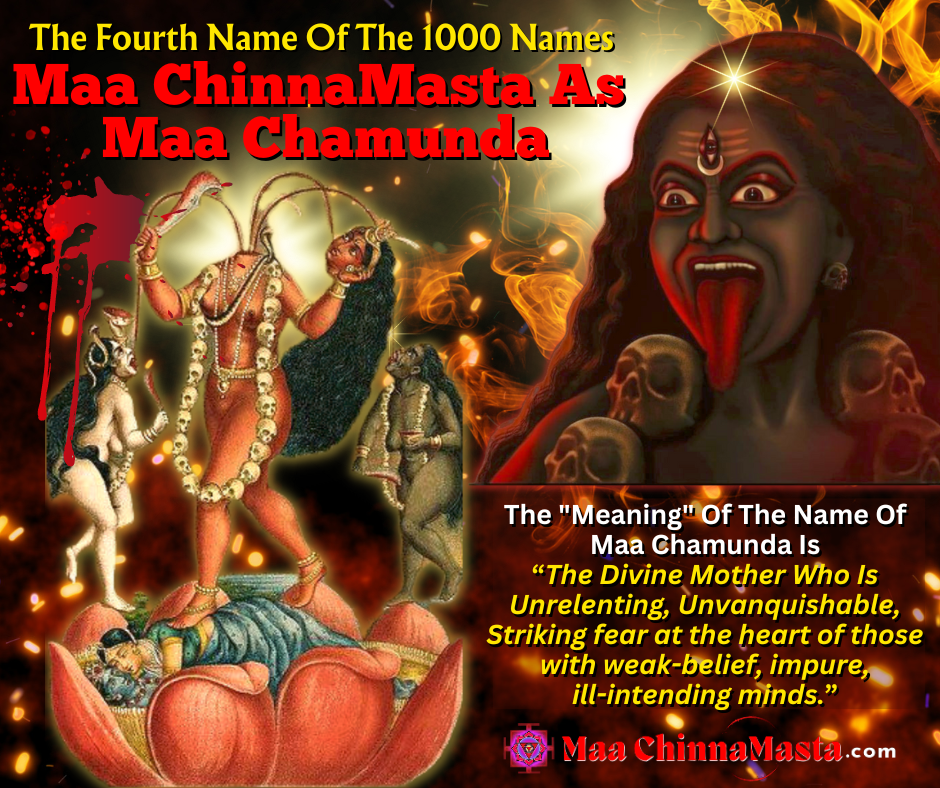
The Fourth “Name” And “Meaning” Through Which devotees praise The Divine Mother Maa ChinnaMasta
The Fourth “Name” Of The 1000 Holy “Names” Through Which devotees praise Maa ChinnaMasta Is Maa Chamunda. Maa ChinnaMasta Revered As Maa Chamunda Is “The Divine Mother Who Is Unrelenting, Unvanquishable, Striking fear at the heart of those with weak-belief, impure, ill-intending minds.”
The Various “Translations” Of The Divine Name
In The Holy Devi Mahatmya, it is mentioned that Maa Maha Kaali Is Given The Name Maa Chamunda When She Delivers the heads of the demon pair, chanda and munda, To Maa Chandika Ambika As trophies of battle. Thus, The Name Of Maa Chamunda, Is Associated With The Slaying Of the demons, And Symbolizes the power of concentrated awareness and the awakening of spiritual consciousness.
“When She Saw those two great asuras, caṇḍa and muṇḍa, Brought Before Her, The Auspicious Maa Caṇḍikā Spoke These Playful Words To Maa Kālī:
“‘Because You Have Overpowered caṇḍa and muṇḍa And Delivered them To Me, You, O Devī, Will Henceforth Be Known In the world As Maa Cāmuṇḍā.’”
– Chapter 7, Verses 26-27 Of The Devi Mahatmya
The following mantra for the worship Of Maa Chamunda begins with the three bījas that together Revere The Divine Mother As Pure Being (Sat), Consciousness (Cit), And Bliss (Ananda)”:
“Om Aiṁ Hrīm Klīṁ Cāmuṇḍāyai Vicce”
Maa Chamunda Severs The Knot Of ignorance And Cuts Through the illusion of duality, Revealing The Absolute. She Is The Immanent-Yet-Transcendent Divine Mother Who Blesses Her sincere devotees With the liberating knowledge, Granting release from all limitations.
Different sources provide additional information About Maa Chamunda. In Bengali, “চামুণ্ডা” Refers To A Specific Form Of Maa Durga Who Destroyed the demons chanda and munda. It is also mentioned that Maa Chamunda Symbolizes the power of concentrated awareness and the awakening of spiritual consciousness.
It is also described that Maa Chamunda Is A Terrifying Form Of Maa Maha Kaali And Is Depicted To Symbolize the old age, death, decay, and destruction that is prevalent in the impermanent world (samsara). The Depiction Of Her Appearance Projects fear and horror And She Is Also worshipped By Other Names, Such As Maa Chamundi, Maa Chamundeshwari, and Maa Charchika.
She Is Also Venerated As One Of The Seven Mothers (Maa SaptaMatrikas). Verse 8.39 Of The Devi Mahatmya Refers To The Seven Forms Of The Divine Mother Collectively As Maa SaptaMatrikas. They Are Depicted As Fierce Forms Of The Divine Mother Who Fight For The Preservation Of the universe. Maa Chamunda As One Among Maa SaptaMatrikas, Defeats the great demon raktabija.
In other sources, Maa Chamunda Is Depicted With Dark Complexion, A Garland Of skulls, And A Protruding Red Tongue. She Is Adorned With Bones, Snakes, And Ashes, Symbolizing the disease and death in this impermanent world. She Has A Third Eye That Burns the universe, And She Is Accompanied By spirits and ghosts.
The Name Of Maa Chamunda Evokes Both Fear And Reverence Among devotees. Maa Chamunda Is A Fierce And Powerful Form Of The Divine Mother Who Is Unrelenting, Unvanquishable, Striking fear at the heart of those with weak, impure, ill-intending minds. She Symbolizes destruction, transformation, and the liberating knowledge that guides the sincere devotees from the relative To The Absolute.
References:
- Anne, B. E. (1994). Chinnamasta: the Aweful Buddhist and Hindu Tantric Goddess.
- The Holy Devi Mahatmya
- https://www.dictionaryfaq.com/%E0%A6%9A%E0%A6%BE%E0%A6%AE%E0%A7%81%E0%A6%A3%E0%A7%8D%E0%A6%A1%E0%A6%BE/bntobn
- https://xn--84b2eds0ge.xn--45brj9c/%E0%A6%AC%E0%A6%BE%E0%A6%82%E0%A6%B2%E0%A6%BE/%E0%A6%B6%E0%A6%AC%E0%A7%8D%E0%A6%A6/%E0%A6%9A%E0%A6%BE%E0%A6%AE%E0%A7%81%E0%A6%A8%E0%A7%8D%E0%A6%A1%E0%A6%BE/
- https://educalingo.com/bn/dic-bn/camunda
- https://en.wikipedia.org/wiki/Chamunda#In_Buddhism
- https://bn.wikipedia.org/wiki/%E0%A6%9A%E0%A6%BE%E0%A6%AE%E0%A7%81%E0%A6%A3%E0%A7%8D%E0%A6%A1%E0%A6%BE#:~:text=%E0%A6%9A%E0%A6%BE%E0%A6%AE%E0%A7%81%E0%A6%A3%E0%A7%8D%E0%A6%A1%E0%A6%BE%20%E0%A6%B9%E0%A6%B2%E0%A7%87%E0%A6%A8%20%E0%A6%86%E0%A6%A6%E0%A7%8D%E0%A6%AF%E0%A6%BE%E0%A6%B6%E0%A6%95%E0%A7%8D%E0%A6%A4%E0%A6%BF%2C%20%E0%A6%86%E0%A6%AC%E0%A6%BE%E0%A6%B0%20%E0%A6%A4%E0%A6%BF%E0%A6%A8%E0%A6%BF%E0%A6%87,%E0%A6%93%20%E0%A6%95%E0%A6%BE%E0%A6%B2%E0%A7%80%20%E0%A6%8F%E0%A6%95%20%E0%A6%93%20%E0%A6%85%E0%A6%AD%E0%A6%BF%E0%A6%A8%E0%A7%8D%E0%A6%A8%E0%A5%A4
